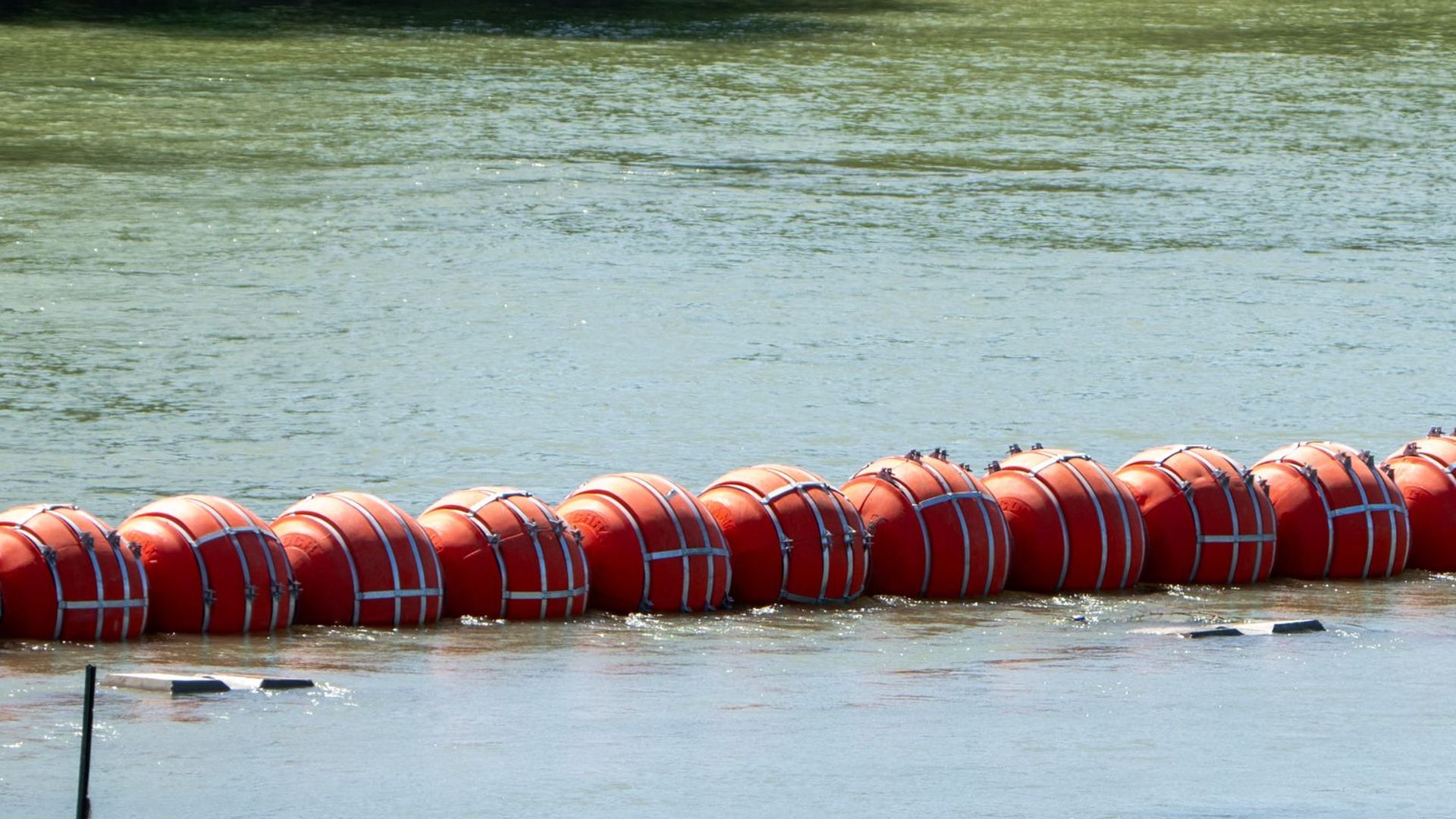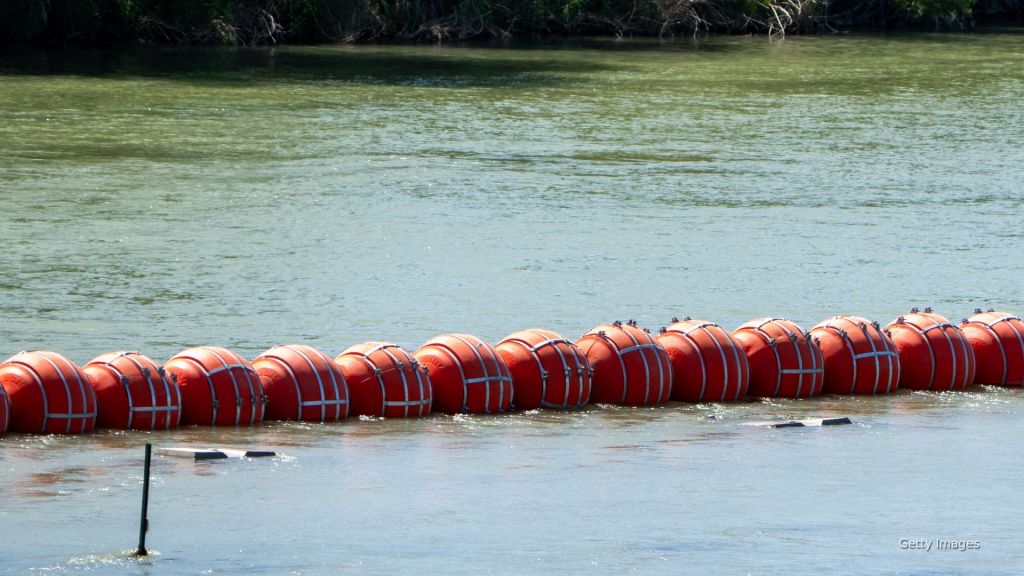
Texas’ buoy border wall in Rio Grande may violate water treaty: Mexico
Jul 17, 2023
By Karah Rucker (Anchor)
Media Landscape
This story is a Media Miss by the right as only 23% of the coverage is from right leaning media.
Learn more about this dataLeft 37%
Center 40%
Right 23%
Bias Distribution
Far
Left
+0
Click to close
Mexico files border boundaries complaint over Texas’ floating barrier plan on Rio Grande
Click to see story on Associated Press News
Mexico files border boundaries complaint over Texas’ floating barrier plan on Rio Grande
Click to see story on abc News
Mexico files complaint over Texas’ floating barriers on the Rio Grande
Click to see story on npr
Mexico files border boundaries complaint over Texas’ floating barrier plan on Rio Grande
Click to see story on NBC Dallas-Fort Worth
Mexico files border boundaries complaint over Texas’ floating barrier plan on Rio Grande
Click to see story on San Antonio Express-News
Mexico files border boundaries complaint over Texas’ floating barrier plan on Rio Grande – West Hawaii Today
Click to see story on West Hawaii Today
Mexico files diplomatic complaint over Gov. Greg Abbott’s floating bo…
Click to see story on The Texas Tribune
Mexico Officially Protests US Floating Barrier on Rio Grande to Stop Illegal Immigration
Click to see story on Hot News
Mexico files diplomatic complaint over Gov. Abbott’s floating border barriers
Click to see story on The Victoria Advocate
Mexico raises concerns over Texas floating barriers on Rio Grande border
Click to see story on jurist.org
Click to close
Mexico files complain with American govt, is US violating treaties with floating barriers on Rio Grande river in Texas?
Click to see story on Hindustan Times
Mexico files complaint accusing Texas of breaking boundary laws with floating barriers
Click to see story on The Hill
Mexico files border boundaries complaint over Texas’ floating barrier plan on Rio Grande
Click to see story on Winnipeg Free Press
Mexico files complaint over Texas’ floating barrier plan on Rio Grande
Click to see story on Star Advertiser
Mexico files complaint over US barrier plan on Rio Grande
Click to see story on Deutsche Welle
Mexico files border boundaries complaint over Texas’ floating barrier plan on Rio Grande
Click to see story on WKMG
Mexico files border boundaries complaint over Texas’ floating barrier plan on Rio Grande
Click to see story on Click on Detroit
Mexico files border boundaries complaint over Texas’ floating barrier plan on Rio Grande
Click to see story on San Diego Union Tribune
Mexico files complaint over Texas’ floating barrier plan
Click to see story on Spectrum Local News
Mexico files diplomatic complaint over Gov. Greg Abbott’s floating border barriers
Click to see story on WFAA 8abc
Mexico files border boundaries complaint over Texas’ floating barrier plan on Rio Grande
Click to see story on KCRG
Mexico files border boundaries complaint over Texas’ floating barrier plan on Rio Grande
Click to see story on Sentinel-Tribune
Click to close
Mexico files border boundaries complaint over Texas’ plan for fl
Click to see story on Washington Times
Mexico files complaint over Texas border control efforts in Rio Grande
Click to see story on New York Post
Mexico files complaint against Greg Abbott’s buoys in Rio Grande
Click to see story on Washington Examiner
Mexico files border boundaries complaint over Texas’ floating barrier plan on Rio Grande
Click to see story on National Post
Mexico files complaint over border boundaries and Abbott’s buoy barrier wall
Click to see story on Hot Air
Mexico files border boundaries complaint over Texas’ floating barrier plan on Rio Grande – Odessa American
Click to see story on Odessa American
Click to close
Far
Right
+0
Click to close
Untracked Bias
Mexico files border boundaries complaint over Texas’ floating barrier plan on Rio Grande
Click to see story on My Mother Lode
Mexico Files Diplomatic Complaint Over Gov. Greg Abbott’s Floating Border Barriers
Click to see story on Austin County News Online
Mexico files diplomatic complaint over Gov. Greg Abbott’s floating border barriers
Click to see story on The Gilmer Mirror
Click to close
33 other sources covering this story
Total News Sources
33
Leaning Left
11
Center
12
Leaning Right
7
Last Updated
10 months ago
Mexico says Texas may be violating international law by installing a border wall made up of orange buoys in the middle of the Rio Grande in the state’s latest attempt to secure the United States border. Mexico’s Foreign Relations Secretary Alicia Barcena said the move could be violating the Mexican Water Treaty of 1944 between the two countries and may be intruding on Mexico’s territory.
“We have sent a diplomatic letter [to the U.S.] on June 26 because in reality what it is violating is the water treaty of 1944,” Barcena told reporters in Mexico City on Friday, July 14.
Barcena said the country is also sending a team out to inspect the new floating wall to ensure Texas kept the buoys on the United States’ side of the Rio Grande.

Texas Gov. Greg Abbott and the Texas Department of Public Safety, which is overseeing the project, said the goal is to stop migrants who enter the country illegally and make a dangerous trek across the river by implementing the new 1,000-foot barrier near the city of Eagle Pass.
More migrants died at the U.S.-Mexico border last year than ever before – drownings at the Rio Grande are part of the reason why. Earlier in July, four migrants including an infant girl drowned while crossing the river.
Gov. Abbott told Fox News on Friday that Operation Lone Star’s installation of “floating marine barriers in Eagle Pass [will] bolster the state’s historic deterrence efforts.”
“In addition to [razor wire], we now have buoys in the water to prevent people from even crossing the middle part of the Rio Grande River and coming into the state of Texas,” Abott said. “Because Texas has done such a prolific job of stopping people from coming into our state, you are seeing a massive increase in the number of people crossing into New Mexico, Arizona, and California.”
But Texas could be forced to take the buoys down after Mexico filed an official diplomatic complaint to the U.S. Barcena said if the buoys impede the flow of water, that would be a violation of the 1944 Water Treaty which requires the river to remain unobstructed.
In addition to Mexico, other critics of the plan include migrant advocates voicing concerns about drowning risks and environmentalists questioning the impact on the river from the buoys.
New marine barriers are being deployed on the Rio Grande to further deter illegal immigrants attempting to cross into Texas.#OperationLoneStar continues to fill dangerous gaps created by President Biden's refusal to secure the border. https://t.co/lADAlzpwzj
— Gov. Greg Abbott (@GovAbbott) July 14, 2023
The buoy border is the latest effort from Abbott to take the border crisis into his own hands, using state resources where he says federal help has lacked.
The Lone Star State has deployed its own National Guard, built new sections of border wall and has bused more than 20,000 migrants from Texas to big sanctuary cities across the U.S.
Media Landscape
This story is a Media Miss by the right as only 23% of the coverage is from right leaning media.
Learn more about this dataLeft 37%
Center 40%
Right 23%
Bias Distribution
Far
Left
+0
Click to close
Mexico files border boundaries complaint over Texas’ floating barrier plan on Rio Grande
Click to see story on Associated Press News
Mexico files border boundaries complaint over Texas’ floating barrier plan on Rio Grande
Click to see story on abc News
Mexico files complaint over Texas’ floating barriers on the Rio Grande
Click to see story on npr
Mexico files border boundaries complaint over Texas’ floating barrier plan on Rio Grande
Click to see story on NBC Dallas-Fort Worth
Mexico files border boundaries complaint over Texas’ floating barrier plan on Rio Grande
Click to see story on San Antonio Express-News
Mexico files border boundaries complaint over Texas’ floating barrier plan on Rio Grande – West Hawaii Today
Click to see story on West Hawaii Today
Mexico files diplomatic complaint over Gov. Greg Abbott’s floating bo…
Click to see story on The Texas Tribune
Mexico Officially Protests US Floating Barrier on Rio Grande to Stop Illegal Immigration
Click to see story on Hot News
Mexico files diplomatic complaint over Gov. Abbott’s floating border barriers
Click to see story on The Victoria Advocate
Mexico raises concerns over Texas floating barriers on Rio Grande border
Click to see story on jurist.org
Click to close
Mexico files complain with American govt, is US violating treaties with floating barriers on Rio Grande river in Texas?
Click to see story on Hindustan Times
Mexico files complaint accusing Texas of breaking boundary laws with floating barriers
Click to see story on The Hill
Mexico files border boundaries complaint over Texas’ floating barrier plan on Rio Grande
Click to see story on Winnipeg Free Press
Mexico files complaint over Texas’ floating barrier plan on Rio Grande
Click to see story on Star Advertiser
Mexico files complaint over US barrier plan on Rio Grande
Click to see story on Deutsche Welle
Mexico files border boundaries complaint over Texas’ floating barrier plan on Rio Grande
Click to see story on WKMG
Mexico files border boundaries complaint over Texas’ floating barrier plan on Rio Grande
Click to see story on Click on Detroit
Mexico files border boundaries complaint over Texas’ floating barrier plan on Rio Grande
Click to see story on San Diego Union Tribune
Mexico files complaint over Texas’ floating barrier plan
Click to see story on Spectrum Local News
Mexico files diplomatic complaint over Gov. Greg Abbott’s floating border barriers
Click to see story on WFAA 8abc
Mexico files border boundaries complaint over Texas’ floating barrier plan on Rio Grande
Click to see story on KCRG
Mexico files border boundaries complaint over Texas’ floating barrier plan on Rio Grande
Click to see story on Sentinel-Tribune
Click to close
Mexico files border boundaries complaint over Texas’ plan for fl
Click to see story on Washington Times
Mexico files complaint over Texas border control efforts in Rio Grande
Click to see story on New York Post
Mexico files complaint against Greg Abbott’s buoys in Rio Grande
Click to see story on Washington Examiner
Mexico files border boundaries complaint over Texas’ floating barrier plan on Rio Grande
Click to see story on National Post
Mexico files complaint over border boundaries and Abbott’s buoy barrier wall
Click to see story on Hot Air
Mexico files border boundaries complaint over Texas’ floating barrier plan on Rio Grande – Odessa American
Click to see story on Odessa American
Click to close
Far
Right
+0
Click to close
Untracked Bias
Mexico files border boundaries complaint over Texas’ floating barrier plan on Rio Grande
Click to see story on My Mother Lode
Mexico Files Diplomatic Complaint Over Gov. Greg Abbott’s Floating Border Barriers
Click to see story on Austin County News Online
Mexico files diplomatic complaint over Gov. Greg Abbott’s floating border barriers
Click to see story on The Gilmer Mirror
Click to close
33 other sources covering this story
Total News Sources
33
Leaning Left
11
Center
12
Leaning Right
7
Last Updated
10 months ago
Unbiased news.
Directly to
your inbox.
Free!
MOST POPULAR
-
 Getty Images
Getty Images
Harvey Weinstein’s rape conviction overturned, victims could see new trial
Watch 2:13
Thursday
-
 Getty Images
Getty Images
Pythons decimate Florida’s wildlife, is eating them the answer?
Watch 2:04
Tuesday
-
 Getty Images
Getty Images
Trump could lose Secret Service protection if found guilty
Watch 2:10
Tuesday
-
 AP Images
AP Images
Argentina asks to join NATO as Milei looks to enhance security, strengthen ties
Watch 1:57
Apr 19
